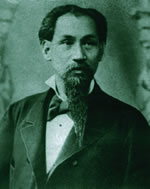Ignacio Ramírez (politician) facts for kids
Quick facts for kids
Ignacio Ramírez "El Nigromante"
|
|
|---|---|
 |
|
| Born | Ignacio Ramírez Calzada 22 June 1818 San Miguel de Allende, Mexico |
| Died | 15 June 1879 (aged 60) Mexico City, Mexico |
| Occupation | Writer, lawyer, poet |
| Nationality | Mexican |
Ignacio Ramírez Calzada (born June 22, 1818 – died June 15, 1879) was an important Mexican thinker and politician in the 1800s. He was known for starting many newspapers that supported new ideas. He often used the pen name El Nigromante, which means the Necromancer. He worked for several presidents and even became the head of the Supreme Court.
Ramírez was part of a group of Mexican liberals during a time called La Reforma. This group included other famous thinkers like Ponciano Arriaga and Benito Juarez.
While most liberals supported laws against the power of the church, Ramírez was one of the few who openly said he did not believe in God.
Contents
Early Life and Ideas
Ignacio Ramírez was born in San Miguel de Allende in Guanajuato. His father, Lino Ramírez, was also a liberal and taught young Ignacio these ideas from a young age.
Ignacio started his studies in Queretaro City before moving to Mexico City. At the Academy of San Juan de Letran, he wrote a paper saying that "there is no God." This caused a big stir, but his teachers still praised his work.
In 1845, he started a newspaper called Don Simplico. The government closed it down in 1846. Ramírez and his friends, Guillermo Prieto and Manuel Payno, were arrested.
Starting in Politics
Soon after, the Mexican–American War began. The government in power fell, and a liberal governor, Francisco Modesto de Olaguíbel, took over the state of Mexico. He asked Ramírez to join his government council.
The federal government then made Ramírez the leader of the Tlaxcala territory. He tried to help with the war effort. However, he had to leave after he stopped a big religious festival. The war with the United States ended shortly after this.
Ramírez moved to Toluca and became a professor. He also started another strong liberal newspaper called Temis y Deucalión. This paper got him into trouble again, but he was found innocent.
In 1852, the governor of Sinaloa asked Ramírez to join his state government. But a conservative government led by Antonio López de Santa Anna took power in Mexico City. Ramírez left Sinaloa and went to Baja California. He found a teaching job there, but he was arrested again. He stayed in prison for eleven months.
Santa Anna was overthrown by the Plan of Ayutla in 1853. Ramírez met Ignacio Comonfort, who would later become president. Comonfort made Ramírez his secretary. But they had different political ideas, so they soon went their separate ways.
The Reform Era
Ramírez then joined a more radical group of liberals. This group included his old friend Guillermo Prieto, Melchor Ocampo, and Benito Juarez. He was a representative for Sinaloa in the important Constitutional Congress of 1856-1857. This congress wrote a new constitution for Mexico. This new constitution led to almost ten years of civil war. He also started another newspaper, El Clamor Progresista.
The new Constitution of 1857 caused a lot of arguments. President Comonfort joined a plan by a conservative general, Felix Zuloaga. This started the Reform War. Comonfort later changed his mind, and Benito Juarez became the constitutional president. Juarez set up his government in Vera Cruz. During the war, Ramírez was put in prison many times. He was freed when a moderate conservative leader declared that prisoners could go free. Ramírez went to Vera Cruz and helped Juarez pass the Reform Laws. By the end of 1860, the liberals had won the war.
The winning Juarez government moved back to Mexico City. Ramírez was made a minister, along with Guillermo Prieto. Ramírez led the Ministry of Justice, Public Instruction, and Development. Here, he worked on many liberal reforms.
French Invasion of Mexico
Ramírez left his government job in mid-1861. At this time, President Juarez had stopped paying foreign debts because of money problems. Mexico was threatened by France, Spain, and England. With Guillermo Prieto, Ignacio Altamirano, and Jose Iglesias, Ramírez started another newspaper called La Chinaca. It was meant to boost the country's spirit against the coming invasion.
A French invasion began in April 1862. The Mexicans pushed them back at the Battle of Puebla in May. In April 1863, the Mexican congress met. Ramírez suggested taking over the monasteries in Puebla to help pay for the war. This idea was accepted. But more French soldiers arrived, and Mexico City was taken in June 1863. Ramírez left the capital and went to Sinaloa. There, he kept publishing newspapers that criticized the Second French intervention in Mexico and the new Second Mexican Empire.
He returned to Mexico City but was found and imprisoned by the Imperial government. He was then moved to Yucatan. Ramírez was freed when the Empire fell in 1867.
Later Life and Legacy
After the Empire fell, Ramírez became part of the liberal group that disagreed with Benito Juárez. Juarez had been president for ten years.
Ramírez was elected as the president of the Supreme Court. President Porfirio Díaz also named him Minister of Justice. Ignacio Ramírez died on June 15, 1879.
See also
- Guillermo Prieto
- Irreligion in Mexico
- Liberalism in Mexico
 In Spanish: Ignacio Ramírez para niños
In Spanish: Ignacio Ramírez para niños

